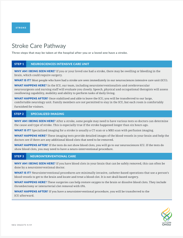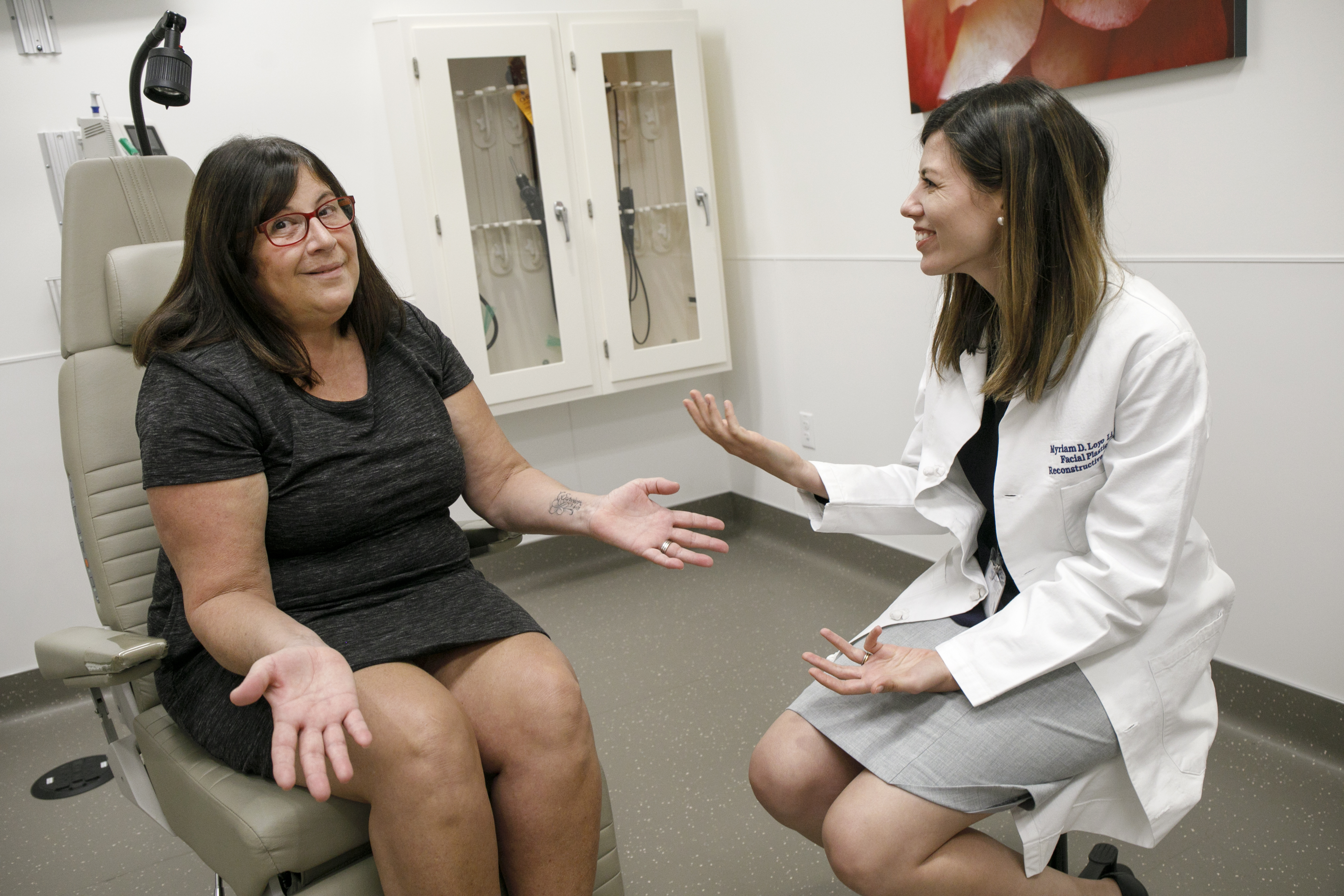Stroke Diagnosis and Treatment
The OHSU Stroke Program is a national leader in stroke treatment. We offer coordinated care from the onset of stroke through recovery and rehabilitation. You’ll find:
- Highly trained neurologists, neurosurgeons, neurointensivists and others who work together.
- Advanced imaging so we can choose the most effective treatment.
- Extensive experience treating rare and atypical stroke disorders.
- Stroke therapies, including the latest blood clot removal methods, that we helped pioneer.
- Around-the-clock access to specialists, including through our Telemedicine Network.
- Complete rehabilitation and support services.
- Access to clinical trials.
Get immediate help
Learn the BE FAST signs of stroke. If you have stroke symptoms, call 911.
Time is brain: From the moment of your first symptom, doctors have only a few hours to use some treatments to prevent brain damage. Immediate treatments may include:
- Medication to dissolve blood clots, typically given up to 4½ hours from first symptoms.
- Treatment to find and remove a blood clot, usually up to eight hours after first symptoms.
- Blood vessel surgery to treat aneurysms, arteriovenous malformations and hemorrhagic strokes.
- Medication to protect brain tissue.
Coordinated care

OHSU’s stroke team provides 24/7 emergency care. We coordinate with our emergency departments, other emergency departments and with hospitals in our Telemedicine Network.
Your care might include three parts:
- Care in our Neurosciences Intensive Care Unit
- Specialized imaging
- Neurointerventional care to remove a clot
A team of experts will confer to determine the best possible treatment for you. Social workers also see all stroke patients within 24 hours of admission. Physical, occupational and speech therapists make daily rounds.
Diagnosis

Rapid diagnosis is crucial in stroke care. Some treatments can be given only within a short time. Our expert 24/7 stroke team uses the latest tests to quickly make a diagnosis and decide the best treatment.
Exam: Specialists do a physical and neurological exam to assess symptoms and health history. They may request blood and other tests. Scans provide precise pictures of brain tissue, blood vessels and blood flow.
CT (computed tomography) or CAT scan: This is usually the first scan. CT scans use X-rays to produce 3D brain images. They help doctors see the type of stroke.
CT perfusion: This advanced imaging test quickly shows the stroke’s location and how much brain tissue can be saved. It can extend the treatment window for some patients, including those who don’t know when their stroke started. Perfusion imaging can also be done by MRI, which uses magnetic fields and radio waves to produce detailed images of the brain.
Carotid ultrasound: This test uses high-frequency sound waves. It quickly shows the insides of your carotid arteries and any plaque buildup. When used with Doppler ultrasound, your doctor can also see blood flow.
Angiogram: Angiograms produce detailed images of blood vessels and blood flow.
- A CT angiogram (CTA) takes X-rays of the brain, often after an injection of dye to highlight blood vessels.
- An MR angiogram (MRA) can be done with or without dye. It uses magnetic fields and radio waves to produce precise images of blood vessels.
- A cerebral angiogram uses advanced X-ray imaging to help doctors guide a catheter (thin flexible tube) through a leg artery to the brain. Dye highlights blood vessels and blood flow so doctors can see any blockages. Your care team can also use the catheter to insert tiny tools to remove clots.
Treatments
Treatments depend on the type of stroke. They include emergency therapies as well as measures to prevent complications and another stroke.
Medication
Ischemic stroke:
- Tissue plasminogen activator or tPA: This “clot-busting” intravenous medication, called a thrombolytic, must be given within 4½ hours of the stroke’s onset to be effective. Using an artery to send it directly to the clot can sometimes extend this window.
- Antiplatelet agents: These medications, including aspirin and Plavix, stop blood fragments called platelets from clumping and forming clots. They are often given soon after ischemic stroke. They are also used to prevent first strokes.
- Anticoagulants: These medications, also called blood thinners, include Heparin, Coumadin and Apixaban. They delay the formation of blood clots. They may be prescribed to people with atrial fibrillation (irregular heartbeat). Those who have had an ischemic stroke caused by a clot that traveled from the heart may also get them.
Hemorrhagic stroke:
- Immediate treatments: Medications can control blood pressure, prevent seizures and reduce pressure in the space between the skull and brain. Some patients may need medications to reverse the effects of anticoagulants and antiplatelet agents.
- Nimodipine: This medication protects brain tissue after a subarachnoid hemorrhage. It relaxes and widens blood vessels that might go into spasm.
Surgery
This surgery removes plaque from inside the carotid arteries. The carotid arteries, one on each side of the neck, deliver blood from your heart to your brain. Plaque can narrow or block blood flow, leading to a stroke. The vascular surgeon makes a small incision in your neck, opens the artery, removes the plaque and closes the artery with stitches or a patch.
Read more about treatments for carotid artery disease.
This procedure temporarily removes a section of skull. It lets neurosurgeons reach the brain to perform bypass surgery, clip aneurysms and treat other disorders. After surgery, the section is put back. Craniotomy can also be done to remove blood and reduce swelling after a hemorrhagic stroke.
This is the brain equivalent of heart bypass surgery. The neurosurgeon uses healthy arteries or veins, sometimes from other parts of the body, to bypass damaged or blocked blood vessels. The aim is to restore blood supply to the brain and prevent strokes.
Highly trained specialists perform endovascular (inside the blood vessel) treatments. They use tiny incisions and advanced imaging to guide catheters and tools through arteries to the brain. There they treat blocked or damaged blood vessels.
This is often used to treat carotid artery disease when surgery isn’t an option.
The doctor guides a catheter with a balloon tip to the narrowed carotid artery, in the neck. The balloon is inflated, stretching the artery and pushing plaque to the sides. A protective device catches any plaque that’s dislodged. Then a stent (a small mesh tube) is placed to hold the artery open.
Occasionally, patients who have intracranial atherosclerosis (narrowed arteries in the brain itself) may have angioplasty and stenting. OHSU research has shown that medication and lifestyle changes are better in most cases.
Read more about treatments for carotid artery disease.
This is a treatment for a hemorrhagic stroke caused by a ruptured aneurysm or arteriovenous malformation (AVM). Doctors use catheters to place platinum coils or a gluelike substance to embolize (seal off) aneurysms and burst blood vessels. This can stop them from rupturing again.
Read more about:
After an ischemic stroke, a doctor guides a catheter through arteries to the brain. The doctor delivers a clot-dissolving medication called tissue plasminogen activator or tPA directly to the clot. This must be done within a few hours after the stroke’s onset.
This is a treatment for ischemic stroke. A doctor, guided by imaging, threads a catheter through a groin artery up to the blocked artery in your brain. The doctor uses a tiny device called a stentriever, or stent retriever, to open the artery and remove the clot
Rehabilitation
Rehabilitation begins while you are in the hospital and usually continues after you go home. Our experienced neurological therapists can help you relearn skills, regain independence and improve quality of life. Rehabilitation may include:
- Communication therapy
- Mobility and motor skills training
- Psychological therapy, such as counseling, a support group and medication for depression
Facial reanimation surgery: Learn how OHSU doctors can restore your smile, improve facial symmetry and help other functions after paralysis from stroke.
Clinical trials
Providers and scientists at the OHSU Brain Institute do extensive research, with hundreds of published papers on stroke. Research includes clinical trials to test new ways to treat stroke. Your care team will talk with you about any trial that might help you.
For patients
- Call 911 now if you or someone else may be having a stroke. Learn the BE FAST signs of stroke.
- Referral: To become a patient, please ask your doctor for a referral.
- Questions: For questions or follow-up appointments, call 503-494-7772.
Location
Parking is free for patients and their visitors.
OHSU Stroke Program clinic
Hatfield Research Center, 13th floor
3250 S.W. Sam Jackson Park Road
Map and directions
Refer a patient
- Refer your patient to OHSU.
- Call 503-494-4567 to seek provider-to-provider advice.
- Find OHSU’s stroke practice standards on our For Health Care Professionals page.
Patient resources
- Find resources for patients and families.
- Learn about stroke prevention.
- Learn how our Telemedicine Network can bring OHSU expertise to your community.
Her smile is back

Meet Jarmila Hawes, who had facial reanimation surgery with OHSU’s Dr. Myriam Loyo Li after a stroke left her with facial paralysis.